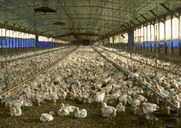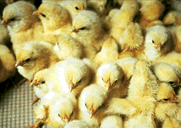AVIAN INFLUENZA

Overview
Avian influenza (or bird flu) is a poultry disease caused by viruses that normally infect birds. This disease is caused by a number of type A influenza viruses.
Domestic poultry may be infected with one of two types of avian influenza viruses:
- The highly pathogenic viruses spread quickly and may kill nearly an entire poultry flock within 48 hours.
- The low pathogenic viruses cause only mild symptoms in chickens (such as ruffled feathers or a drop in egg production).
These avian influenza viruses usually do not infect humans. However, cases have occurred in humans outside the United States. The disease can be transmitted to poultry workers or others who contact infected poultry or contaminated surfaces. Examples of workers at risk include the following:
- Poultry growers and their workers
- Service technicians of poultry processing companies
- Caretakers, layer barn workers, and chick workers at egg production facilities
- Workers involved in disease control and eradication (including Federal, contract, and company workers)



Photos courtesy of U. S. Department of Agriculture
The first cases of human infection with the highly pathogenic avian influenza virus H5N1 occurred in 1997 in Hong Kong. This highly pathogenic virus has not been reported in birds or humans in the United States.
Scientists are concerned about the highly pathogenic H5N1 virus for three reasons:
- It threatens domestic poultry, especially chickens, throughout the world.
- It has passed from poultry to humans and caused serious illness and death.
- It may change into a form that is highly infectious in humans and spreads easily from person to person.
The H5N1 virus is excreted in the droppings, saliva, and nasal secretions of infected birds. The virus is believed to enter humans through the mouth, nose, eyes, and lungs. Scientists believe that the virus has been transmitted to humans from contact with one of the following:
- Infected poultry that was sick or dead
- Droppings of infected poultry
- Contaminated litter
- Contaminated surfaces such as egg collection containers
Although the human health risk of exposure to low pathogenic avian influenza viruses is not known, protective measures should be taken for anyone likely to have prolonged exposure to any avian influenza virus in an enclosed setting.
Resources
View Related Topic in
Contact Us:
- National Institute for Occupational Safety and Health (NIOSH)
- Centers for Disease Control and Prevention
- 800-CDC-INFO
(800-232-4636)
TTY: (888) 232-6348 - New Hours of Operation
8am-8pm ET/Monday-Friday
Closed Holidays - cdcinfo@cdc.gov


